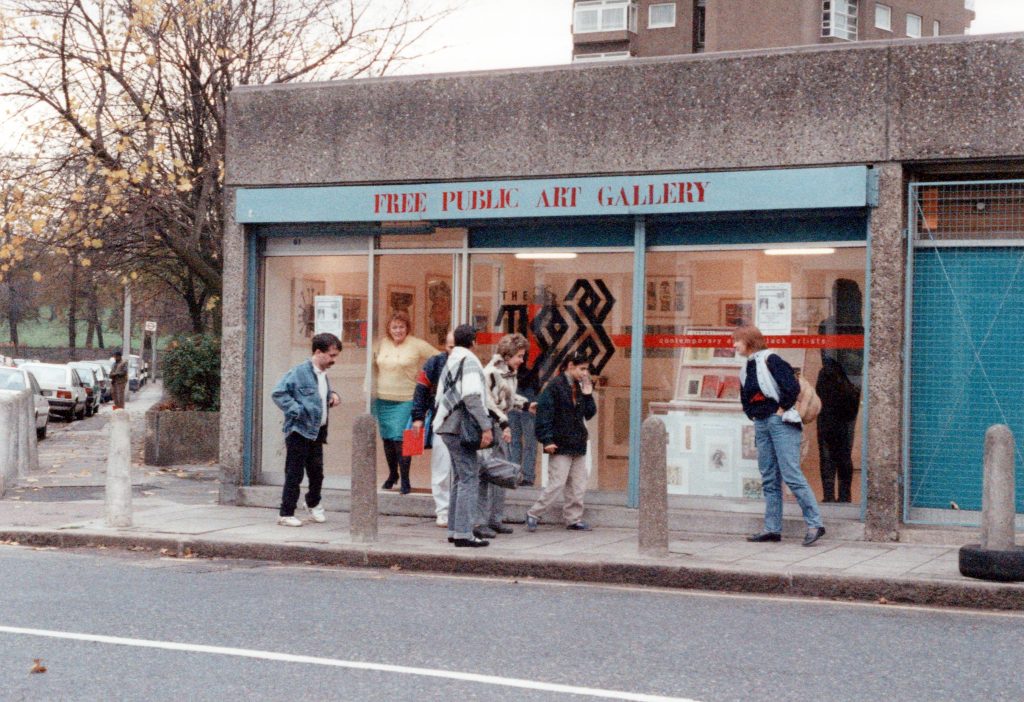
198 Contemporary Arts and Learning is a centre for visual arts, education and creative enterprise.
OUR VISION is to be an influential national model of artistic excellence, pushing creative boundaries while giving voice and space to under-represented artists, communities and cultures.
OUR MISSION is to deliver exemplary arts, education and enterprise programmes, and to support emerging creatives of colour into the creative and cultural industries. We aim to make visible hidden issues regarding social change and emerging cultural identities through programming and partnerships.
Our stakeholders include:
- Artists and curators of colour
- Young people of colour seeking careers in the creative and cultural industries
- Audiences seeking more diverse visual arts
- Our local community
- Partner arts organisations
- Partner community organisations
Our work is framed by our local communities and the history of the Brixton uprisings from which we sprang; informed by a policy context that calls for greater action on equality, and shaped by unfulfilled demand for diverse visual arts and new pathways to creative careers.
Founded in 1988, 198’s motivation initially focused on the need to provide a platform for Afro-Caribbean and Asian artists as part of the Black arts movement. For nearly 30 years this work has evolved and continued to develop with projects that consider the work and study of emerging cultural identities, through exhibitions, workshops, education projects and critical debate with artists, thinkers, activists, young people and local and artistic communities. We advocate for diversity within the visual arts and provide opportunities for those wishing to develop careers in the creative and cultural industries. In 2017, 198 achieved Arts Council National Portfolio Organisation status as part of a consortium with Photofusion and Raw Material. A further validation of its important work came later in 2017 when the Venice Biennale launched its first diaspora pavilion, with 6 of the 12 chosen artists having exhibited at 198.
With 198’s impact in the arts, cultural and education world growing exponentially, an ambitious project was undertaken to expand and enhance its premises. This began with the purchase of the building from Lambeth Council in an Asset Transfer, and continued with major fundraising efforts resulting in obtaining £1,350,000 for a capital project which has resulted in adding two new floors to the building. This has effectively tripled the exhibition space on the ground floor, provided six new workspaces/studios for rent on the first floor, while the second floor now houses the Factory Youth education and enterprise programme. Along with creating income potential to strategically underpin financial sustainability in the long term, this building allows a lifestage approach, starting with education and training for young people in creative and cultural fields, providing studios and workspaces for creative enterprises, exhibition spaces for upcoming and established artists as well as a range of spaces for hire for local, national and international events.
Our Guiding Principles
We are embedded in our Community and have a strong commitment to Diversity, Equality and Inclusion.
We value Honesty, Integrity and Transparency and this underpins our activities.
We seek Artistic Excellence and support Freedom of Expression.
We promote Personal Development and work to provide opportunities for our audiences and participants.
And we understand we can’t achieve all this alone, so we work in genuine partnership and collaboration with organisations and individuals who share our values and aspirations.
How We Work
198 is a small, agile organisation which has managed to achieve national impact because we’ve not been afraid to be experimental or challenging when working to develop innovative projects in collaboration with upcoming artists, curators, educators and partner organisations.
We are governed by a board of trustees who develop and guide the strategic direction together with staff and stakeholders. As a registered charity we work in the public interest, generating funds through enterprise, as well as from donations and grants.
Who We Work With
We work with many partners in the private, public and community sector to develop our artistic programme, promote community participation and engage audiences. Our partners range from local government departments, membership organisations and professional bodies to educational institutions, arts organisations, development agencies and community groups.
Current key partners include Arts Council England, Lambeth Council, Greater London Authority, National Lottery Heritage Fund, The Walcott Foundation, Capita PLC, Power to Change Community Business Fund, Garfield Weston Foundation, Cockayne Trust, Span Trust, Arnold Clark Community Fund.
We also work with like-minded organisations such as Photofusion, Autograph ABP etc. If your organisation is interesting in collaborating with 198 please get in touch.
Our History
198 Contemporary Arts and Learning, called ‘198’ by many locals, is located on Railton Road, Brixton in south London. Brixton is a district in the borough of Lambeth: a richly multicultural area with a population of locals and residents from across the world, most notably African Caribbean immigrants. Since the 1950s the African Caribbean community have contributed a diverse cultural feel and a dynamic anti-establishment edge to the borough. To those who are familiar with life in London today, Brixton has become a focal point of creative expression for many local, immigrant and refugee people – a space where there are more languages and dialects spoken per square mile than most other places in Britain.
198 grew out of the social unrest of the 1980’s, when the racism and discrimination in urban UK cities was exacerbated by the introduction of SUS laws which meant that mostly young Black men were indiscriminately and randomly stopped and searched openly in the street. This increased conflict and tension between the local community and police in the summer of 1981 lit a powder keg of resentment and frustration, resulting in some of the most serious street disturbances seen in Britain since the war. Four years later, in 1985, rioting in Brixton erupted again when police stormed the home of Black mother Cherry Groce. Black Community leaders worked hard to bring peace to the streets while visits by the Prime Minister and the Scarman Inquiry were the beginnings of a political commitment to change. From the debris of this social unrest arose opportunities for black community leaders not only to have their voices heard, but also to implement regenerative projects to empower the local community to express themselves politically, economically and creatively. Funding provided by government to stimulate social regeneration in the community was an important catalyst for supporting Roots Community Limited, which in 1988 became 198 Gallery.
Roots Community began from a chance conversation between Zoë Linsley-Thomas and John ‘Noel’ Morgan. All her adult life, Zoë was an engaged activist for Black rights and equality, starting in the 1950’s with advocating to obtain housing and social welfare support for many people from the Windrush generation. At the time she was running the Vargus Social Club for elder Afro-Caribbeans, in Landor Road with John. Out of this first conversation developed a partnership that would grow over the coming years, forming the initial ideas that would take root and see the emergence of Roots Community Association at 198 Railton, Road, just a few minutes walk from the Brixton ‘Frontline’, the scene of the start of 1981 uprisings. Roots Community had a dual purpose: it offered the opportunity to Caribbean Elders to play dominoes and an opportunity for both local and national Black artists to exhibit their work. But the demand to exhibit works of art far outweighed the need for dominoes and as a consequence, the venue became a showcase for the art of the local and Black community. Central to the ethos of 198 Gallery was a commitment to the community, which would take its exhibitions and projects from the ‘Frontline’ of Railton Road into the international visual arts arena. Over the years 198 Gallery gradually expanded its premises from two to three exhibition spaces, creative offices and a digital media studio.
198 Gallery’s early curatorial policy was embodied in the project to fundraise and commission the first public sculpture by a Black artist in the UK. The First Child, by Jamaican artist Raymond Watson is a memorial to the 116 children who were murdered by the Afrikaner police force in Soweto in 1976. The memorial stands in Max Roach Park in Brixton. Encouraged by the success of this project, 198 moved towards supporting artists from a wider range of backgrounds to extend the debate on race and emergent identities in the UK.
The exhibitions provided the material for a structured art education programme and 198 began to address the growing concern within the community – that of youth. Training, participation and showcasing for young people has been integral to 198 since its foundation. In 2007, 198 changed its name to 198 Contemporary Arts and Learning to reflect this commitment and the integrated nature of its artistic and participation programmes. In 2010, 198 set up HustleBucks, a social enterprise, led by local young people and acquired a retail space in Brixton Village, Brixton market with the aim of creating a hub for youth enterprise in Lambeth.
